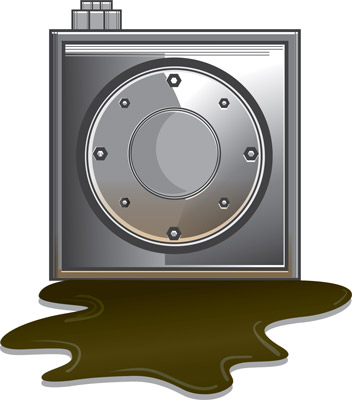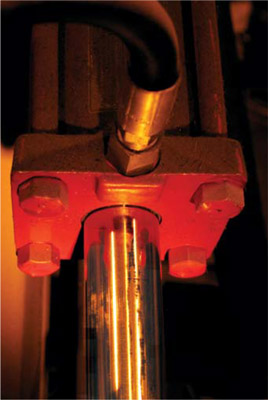Ask The Experts
“Our gearbox, which leaks excessively, is close to the end of its life. It currently uses an ISO 680 EP oil, but we would prefer to use a lubricant that would stem some of the leakage and allow the gearbox to continue running until the next scheduled turnaround. What would you suggest?
 hen it comes to leakage, the only real solution is to take down the machine and repair it in order to stop the leak. As oil continues to flow from the gearbox, there are obvious safety concerns involved with exposing people and the environment to the gear oil. This also doesn’t take into consideration the cost of the oil that is leaking. Synthetic oils can be very costly, and having a component that leaks these fluids is similar to throwing money down the drain.
hen it comes to leakage, the only real solution is to take down the machine and repair it in order to stop the leak. As oil continues to flow from the gearbox, there are obvious safety concerns involved with exposing people and the environment to the gear oil. This also doesn’t take into consideration the cost of the oil that is leaking. Synthetic oils can be very costly, and having a component that leaks these fluids is similar to throwing money down the drain.
Provided that the component can be taken down and repaired in the near future, there are some options to “Band-Aid” the problem. Several manufacturers make compounds that can be added to the oil to help mitigate leakage. These compounds work along the same lines as radiator sealants that form deposits at the point of leakage. As with introducing any aftermarket product to your oil, this should only be done after careful consideration and testing to ensure there will be no ill effects on the oil or machine.
Other types of products that can be used are touted as seal enhancers. These fluids and pastes are manufactured with synthetic bases and will cause seal material to swell. As the seal swells, it slows the leakage. When the machine is able to be taken out of service, the seal should be replaced and the gearbox flushed to remove any traces of the seal compound that has been introduced.
Filling the gearbox with grease is another simple solution that has been used successfully. Grease has lower flow characteristics than oil and will not leak as fast. While grease will lubricate the gears effectively, more heat will be generated within the gearbox. Since grease does not dissipate heat as well as oil, the temperature should be monitored.
All of these solutions are not true fxes but simple patches that can help until the gearbox can be taken out of service and properly repaired. Keep in mind that after adding anything to a component other than the appropriate lubricant, it should be removed and the interior surfaces flushed to eliminate all risks of incompatibility. All seals should also be replaced to reduce future leakage.
“Over the past several months, we have noticed that one of our hydraulic cylinders speeds up by itself intermittently. Would you have any idea as to why this is happening and if this is a common problem?”
 An increase in hydraulic cylinder speed is a rare occurrence. To better understand the problem, let’s consider the much more prevalent case of decreasing speed and apply the opposite logic.
An increase in hydraulic cylinder speed is a rare occurrence. To better understand the problem, let’s consider the much more prevalent case of decreasing speed and apply the opposite logic.
In terms of hydraulic systems, a reduction in performance is usually the frst clue that a problem has manifested in the system. This is most often indicated by longer cycle times and slower operation. The root cause of these failure symptoms can frequently be traced back to fluid flow. The fluid flow in a hydraulic system determines actuator speed and quickness of response. Loss of flow will equate to loss of speed.
Applying this same logic to an increased cylinder speed would mean that more flow is occurring. What could happen in a hydraulic system that would cause an increase in flow over time? Internal Leakage – If an internal leak becomes clogged, the flow would inherently increase.
Viscosity Change — If the viscosity were to decrease, the flow would increase (depending on the pump and system design).
Filter Collapse or Bypass Malfunction — If the flter was causing reduced flow and then burst, or there was a malfunction with the bypass that allowed flow to increase, both would result in an increased cylinder speed.
Air Entrainment — Air in the fluid will cause poor (slow) performance. If the air problem is corrected, the system will speed up.
Oil Line Cleared — If a restricted or blocked oil line becomes unrestricted/ unblocked, the fluid flow will increase.
Change in Load — If the load on the cylinder is reduced, it may increase cylinder speed.
These are just a few things that may be plaguing the hydraulic system. In order to provide a more comprehensive diagnosis, more details would need to be known, such as the system design, seal health, flter type and age, contamination levels, cylinder position, etc.
Keep in mind that not all hydraulic cylinders are created equal. It is estimated that up to 25 percent of mechanical equipment failures are design related. In regards to hydraulic cylinders, this suggests as many as one in four are not adequately designed for the application in which they are operating. So if the hydraulic cylinder suffers recurring failures, it is likely that design modifcations will be required to break the cycle of failure and repair.
If you have a question for one of our experts, email it to editor@machinerylubricationindia.com
